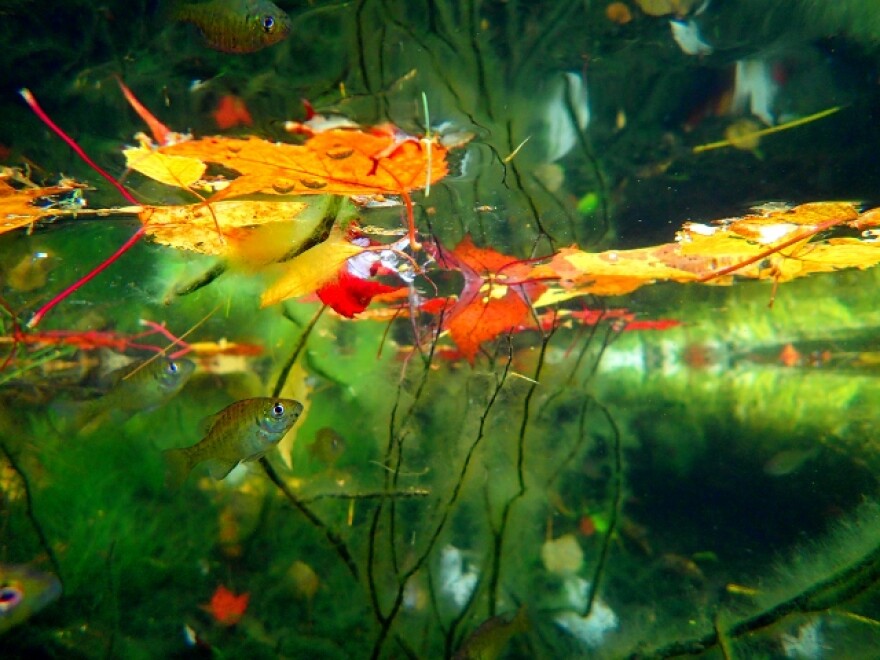For this month’s Field Notes, Gretchen Gerrish of UW-Madison’s Trout Lake Station tells us of the life and death of leaves.
Scooping mud from the bottom of Trout Lake with a group of visiting seventh grade science enthusiasts, they ooh and awe over the variety of rocks coming up and a severed crayfish claw, but the real treasure is when our mechanical mud scooper (also known as an Eckman dredge) retrieves a leaf from the bottom of the lake. We are in search of aquatic insects, worms, snails etc. and a single decaying leaf often provides a plethora of crawling, wriggling organisms for the students to see. One student asks, ‘Will they spend their whole life of the same leaf?’…the answer, ‘Maybe.’ While many insects move from leaf to leaf, feeding and taking shelter, there are more than enough resources in and on one leaf to feed a group of small aquatic insects throughout their complete larval development.
Leaves are a major source of energy feeding our forest canopies, forest floors, streams and lake bottoms.
As spring approaches, we look at the budding of leaves to indicate that trees are emerging from their winter dormancy. As leaves emerge, the trees begin circulating sugars and cycle into their growth period. It is a common misconception that trees get energy and their mass from the soil. Roots in the soil are important for absorbing water and key nutrients like nitrogen and phosphorous. But trees, like you and me and most life on earth, are made up of mostly carbon. Where did all that carbon come from? It was trapped from the air by…leaves. Imagine all the big strong trees surrounding you in the forest. Their entire structure was constructed by reweaving carbon dioxide particles from the air. We use the term ‘magical’ when we see something appear out of thin air. Leaves perform this magical task over and over every day. Using green-colored chlorophyll pigments, the leaf captures sunlight which turns the chemical ‘crank’ within, to pull in carbon dioxide and to make sugars that grow the tree upwards and outwards.
As the sun moves further from earth in the fall the sunlight is not enough to drive the chemical ‘crank’ within a leaf, so the tree selfishly takes back most of the energy and water from its leaves. The tree reclaims the green pigments that are high in energy, leaving only yellow, orange and red pigments that are called carotenoids. These pigments make for beautiful fall colors but indicate that the tree’s growing season is over. As the dried leaves are abandoned to the forest floor, the tree survives the winter on the stored energy claimed over the summer months by its leaves.
Leaves on the forest floor support an entire food web of detritivores, which are organisms that feed on dead and decaying matter. Fungi and bacteria breakdown the leaf material and are consumed by a whole suite of organisms that live within decaying leaves. Flies and maggots, woodlice, slugs and snails, millipedes, worms etc. feed on the decaying leaf material. Voles, birds, racoons, skunks and even bears are top predators in this food web when they dig for grubs and bugs. That earthy forest smell that we have all grown to love in the northern forests is the scent of the detritivore food web hard at work recycling leaves to feed a diverse community and to provide nitrogen and phosphorous that will be used in future forest growth.
In lakes and streams, leaves are so important that we often categorize water-dwelling insects into shredders, scrapers and grazers depending on how they chew or scrape leaf, plant and rock structures for food collection. Leaves are a major food source in our watershed, especially in small, shaded streams, where there is limited light for algae to grow. Bacteria and fungi quickly begin feeding on a leaf as it sinks below the water’s surface and soften the leaf making it edible to other organisms. Mayflies, stoneflies, caddisflies, and many fly larvae live in the water for a year or more while they develop. These insects often scrape fungi and bacteria from the surface of a leaf or chew the leaf to shreds as they feed. Decaying leaves in streams and lakes hold a huge number of aquatic insect larvae which provide the main food source for fish like pumpkinseed, white suckers, and perch. These larvae emerge each year as adult insects and are consumed by trout, bats and various bird species.
As the students run their hands through the lake ‘mud’ looking for bugs, they observe that the ‘mud’ twenty feet down in Trout Lake is just a whole bunch of tiny shredded leaf pieces. The students return to the bus with each step touching on the blanket of last year’s leaves and I am reminded how a leaf, in life or death, promotes new growth as we move into the spring thaw.





